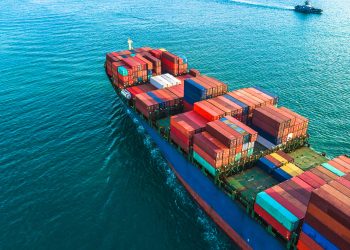4,000 teu containership to be powered by LNG
 Leading international classification society Bureau Veritas has given approval in principle for the basic design of a 14,000 teu containership to be powered by LNG. The design was developed in a joint industry project between Korea’s Daewoo Shipbuilding & Marine Engineering, liner major CMA-CGM and Bureau Veritas.
Leading international classification society Bureau Veritas has given approval in principle for the basic design of a 14,000 teu containership to be powered by LNG. The design was developed in a joint industry project between Korea’s Daewoo Shipbuilding & Marine Engineering, liner major CMA-CGM and Bureau Veritas.
Says Jean-Francois Segretain, deputy technical director, Bureau Veritas, “The market will determine when these ships can be ordered and built, but this is a real milestone as for the first time we have a fully worked and approved design for a main line ultra-large containership running on LNG. After an in depth HAZID analysis we can say with confidence that there are no technical or safety barriers to introducing LNG as a fuel for long-haul large containerships. Major operational savings are deliverable, combined with very much lower air emissions. And the key feature of this design is that the vessel can also run on HFO if required, increasing flexibility in the period before LNG bunkering is widely available.”
The 14,000 teu vessel will be powered by an ME-GI (MAN Electronic – Gas Injection) 2-stroke dual fuel engine made by MAN Diesel. This delivers the highest efficiency among existing propulsion systems and works by simultaneous dual burning of HFO and LNG. In minimum fuel and maximum gas mode around 10 per cent of the fuel is oil, providing overall CO2 emission reductions in the order of 23 per cent and SOX reductions of 92 per cent.
The basic design is for a 365.5 m loa vessel with a design draft of 14 m and a design speed of 24 knots. In the dual fuel configuration a 22,490 cu m LNG prismatic tank would be installed under the forward accommodation, and there would be a bunker tank for heavy fuel oil aft of 4,430 cu m capacity. The LNG tank would be a Daewoo patent ACT-IB Aluminium Cargo Tank – IMO type B independent LNG tank with PUF(Poly-Urethane Foam) panel type insulation.
The main engine would be rated at MCR 72,285 kW and the vessel would have a range of 25,000 miles if fully bunkered.
Explains Segretain. “Compared to the same ship with a conventional fuel power plant there will be extra capital cost for the engine and for the LNG tank and gas handling system, and there is a loss of cargo space equivalent to 438 teu to make room for the gas tank and equipment. But the extra capital cost and the loss of earnings on a theoretical full ship are more than offset by the fuel economies and lower emissions of this design.”
Source: BV





























































